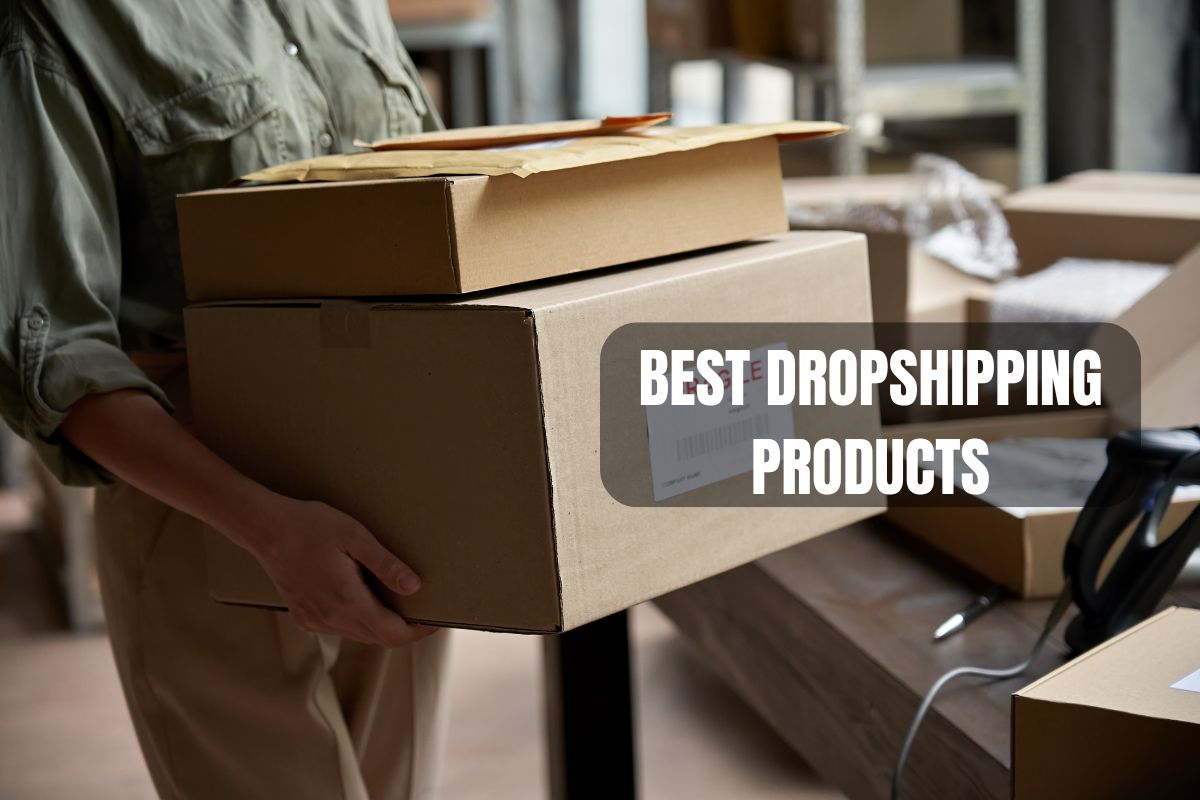Branded dropshipping is an e-commerce strategy enabling you to sell products directly to consumers without holding inventory, but with a unique twist: your brand is at the forefront. Unlike traditional dropshipping which often involves generic products, this approach allows you to create and cultivate your own brand. By leveraging this model, you’re offering customers products under a label they can recognize and trust. This not only adds a layer of credibility to your online store but also elevates the perceived value of your products.
Establishing a strong brand as part of your dropshipping business can set you apart in a competitive market. It builds customer confidence and loyalty, as shoppers often prefer to purchase from a business that appears professional and trustworthy. Moreover, a solid brand identity communicates that you are knowledgeable in your niche, enhancing your store’s reputation. Through strategic branding efforts—from product selection to customer service—you can create an unforgettable experience that resonates with your audience.
By adopting branded dropshipping, you are committing to a long-term vision that goes beyond just selling products; you’re creating an experience and a legacy. Your attention to detail, from your website design to the packaging, reinforces the customer’s decision to buy from you. So if you’re looking to establish an online presence that can thrive amidst market shifts and changing consumer preferences, branded dropshipping provides the perfect opportunity to do so, while carving a distinct identity in the ecommerce landscape.
Understanding Branded Dropshipping
Branded dropshipping allows you to sell products under your brand, giving you the power to create a distinct brand identity and potentially higher profit margins. This approach to e-commerce focuses on quality and customer loyalty.
The Basics of Dropshipping
Dropshipping is a retail fulfillment method where you sell products without holding inventory. Instead, when a customer purchases a product from your online store, the order is sent to a third-party supplier who ships the product directly to the customer on your behalf. This process minimizes risk and investment while allowing you to focus on marketing and customer service.
- Key Components:
- Supplier: A third-party entity that stocks the product and handles shipping.
- Retailer (You): The storefront that markets the products to consumers.
- Customer: The end recipient of the product, who purchases from your online store.
This model relies significantly on finding trustworthy suppliers who can deliver products on time and maintain product quality.
Differences Between Branded and Unbranded Dropshipping
Branded Dropshipping:
- Involves selling products with your own custom branding.
- Aims to cultivate brand identity, fostering customer recognition and loyalty.
- Tends to have higher profit margins as customers are often willing to pay more for branded products that they perceive to have higher value.
| Branded Dropshipping | Unbranded Dropshipping | |
| Product Label | Your brand name and logo | Manufacturer’s label |
| Customer Loyalty | Higher potential due to brand value | Lower, as products are generic |
| Profit Margin | Potentially higher due to perceived value | Usually lower, as competition is based mainly on price |
Unbranded Dropshipping:
- Products are sold as they are, without any customization or labeling.
- Competitive advantage is typically price-driven, rather than brand-driven.
- Usually has lower profit margins as you compete with many sellers offering the same generic products.
When you choose branded dropshipping, you invest in product quality and brand building, which can result in a unique market position and customer base that recognizes and trusts your brand.
Building a Strong Brand Identity

In the competitive landscape of e-commerce, your brand identity is the anchor that differentiates your offerings from the rest. It’s a blend of visual cues and messaging that conveys your brand’s values and promise to customers.
Choosing Your Niche and Brand Name
Selecting a niche is foundational to shaping your brand identity. Your niche carves out a space in the market that your brand can authentically occupy and serve. Once identified, crafting your brand name is the next critical step. It should resonate with your niche while being memorable, easy to pronounce, and should hint at the unique value you provide. For example, a sustainable clothing dropshipping store might include ‘eco’ or ‘green’ to immediately convey its environmental focus.
Developing Your Logo and Design Elements
A logo is often the cornerstone of brand recognition. Designing a logo requires a delicate balance: it must be simple yet evocative of your brand’s spirit. Think of the Nike swoosh or Apple’s apple—each a symbol distilled to its essence yet full of meaning. Your other design elements—like packaging and website layout—should align with the logo’s style, helping to build a consistent visual language for your brand.
Creating a Consistent Color Scheme and Font
Colors and fonts are subtle yet powerful tools in establishing brand identity. Choosing a color scheme and font that reflect your brand’s tone and values is essential. Consistency across your website, marketing materials, and products ensures that customers will recognize your brand at a glance. Stick to a limited color palette for a professional and cohesive look and use a maximum of two complementary fonts for readability and brand reinforcement.
Crafting Your Online Presence

As you establish your branded dropshipping business, the digital landscape is your primary gateway to reaching customers. Your online presence must be meticulously designed and continuously nurtured to ensure a seamless shopping experience and to leverage powerful marketing channels.
Designing an Effective Website
Your website is the cornerstone of your online presence. Prioritize a clean, visually appealing design that aligns with your brand image to make a strong first impression. Use high-quality images and ensure that your branding is consistent throughout the site. It’s vital to incorporate SEO best practices into your content to improve visibility and attract organic traffic.
- Homepage Layout: Keep it clutter-free, highlight your unique selling proposition.
- Branding Elements: Logo, color scheme, and typography must be brand-aligned.
- Mobile Responsiveness: Ensure your site is fully functional on mobile devices.
Optimizing Website Navigation and Product Descriptions
Smooth navigation is essential for a positive user experience in your online store. Organize your products into intuitive categories and subcategories. When it comes to product descriptions, focus on clear, benefit-driven language that emphasizes the value of your offerings.
- Navigation Menu: Logical, easy-to-follow structure.
- Detailed Filters: Allow customers to sort products by various parameters.
- Call-to-Action Buttons: Use compelling verbs and contrasting colors for visibility.
Establishing a Powerful Social Media Footprint
Your social media platforms are channels for engagement and brand storytelling. Develop a content strategy that represents your brand’s voice and values. Regularly post updates, behind-the-scenes looks, and customer testimonials to create a community around your brand.
- Platforms to Consider:
- Instagram: For visual storytelling and influencer partnerships.
- Facebook: For detailed posts, customer interactions, and reviews.
- Twitter: For real-time updates and customer service.
Each post you make is a piece of marketing material that should contribute to a cohesive brand narrative. Remember, consistency is key to maintaining a trustworthy and professional image online.
Selecting the Right Suppliers and Products

Selecting the right suppliers and products is crucial to building a successful branded dropshipping business. Your choices will directly influence the quality, reliability, and customer perception of your brand.
Partnering with Reliable Suppliers
When entering the world of dropshipping, aligning yourself with reliable suppliers is of paramount importance. Seek out suppliers with a robust track record of timely deliveries and consistent communication. Suppliers like AliExpress or CJDropshipping are popular starting points due to their wide array of options and user-friendly platforms. However, take the necessary steps to validate their credibility by checking customer reviews and ordering samples.
Choosing High-Quality Products for Your Brand
Your brand’s reputation will rely heavily on the quality of the products you offer. Conduct meticulous research into each product’s reviews and the supplier’s history to ensure they meet your brand’s standards. For success in branded dropshipping, curating a product selection that aligns with your brand identity while also maintaining high customer satisfaction is essential.
- Product Quality: Look for items with positive feedback and high ratings.
- Brand Alignment: Ensure every product reflects your brand’s values and image.
Product Customization Options
To stand out in the dropshipping market, offering customization options can be a competitive advantage. Consider suppliers that provide private label solutions for a more personalized consumer experience. Print-on-demand services allow for unique designs and can be a part of your product selection, giving customers something they won’t find elsewhere. Customization helps to foster a stronger connection between your customers and your brand.
- Private Label: Incorporate your brand’s logo and packaging through suppliers offering private labeling.
- Print-on-Demand: Utilize services that allow you to design bespoke products tailored to your audience’s preferences.
Marketing and Customer Engagement

Effective marketing and customer engagement are pivotal in developing customer loyalty and fostering repeat purchases. By leveraging targeted marketing materials and nurturing relationships, your dropshipping brand can build trust and encourage engagement on your social media accounts.
Building Relationships through Marketing
Marketing isn’t just about selling; it’s about creating lasting relationships. To cultivate these connections with your audience, your strategy should be two-fold: utilize advertising campaigns to build brand awareness and follow up with personalized communication to strengthen customer loyalty. For instance, an excellent platform emphasizes the importance of relatable branding and targeted campaigns to acquire sales prospects.
Creating Engaging Content for Your Audience
Content is king, and creating engaging material is crucial for your dropshipping business. Your content strategy should center around what resonates with your audience, whether it’s educational blog posts, eye-catching infographics, or interactive videos. The goal is to provide value that goes beyond the products you sell, establishing your brand as a trusted authority in your niche. Research indicates that a thoughtful social media integration can significantly enhance your brand’s reach.
Leveraging User-Generated Content
Incorporate user-generated content to amplify customer trust and engagement. When your customers share their experiences, it acts as social proof, influencing others and often resulting in repeat purchases. Encouraging your audience to share their product photos and reviews on platforms like Instagram can position your brand strongly and personalize the user experience. Studies suggest that branded hashtags and consumer participation can significantly impact a dropshipping business’s growth.
Operational Excellence
Achieving operational excellence in branded dropshipping hinges on efficient processes and robust strategies. This ensures your customers receive their orders promptly, and your brand reputation remains positive through a smooth operation that is invisible to your end customer.
Streamlining the Ordering and Fulfillment Process
Your success in dropshipping largely depends on a seamless ordering and fulfillment process with a reliable third-party supplier. To expedite this, ensure there’s a robust system where orders are automatically forwarded from your store to your supplier. Ideally, your supplier’s system should integrate seamlessly with yours, providing real-time updates on inventory and shipment tracking. This connectivity keeps your customer base well-informed and minimizes the chance of errors in the ordering process.
Inventory Management Strategies
Even though you don’t hold the inventory, it’s critical to have a finger on the pulse of your supplier’s stock levels. Utilize tools and software that offer inventory management capabilities, allowing you to monitor stock and predict demand. This forward-planning can reduce the risk of stockouts and backorders, both of which significantly impact your customer experience. Here is a simple example of how you might organize this information in a table:
| Product | Inventory Level | Reorder Threshold | Supplier Lead Time |
| Brand T-shirt | 150 | 30 | 2 weeks |
| Logo Mug | 100 | 20 | 1 week |
Customer Service and Experience
A cornerstone of operational excellence is the provision of top-notch customer service. Your support structures must be responsive and hepful, addressing concerns and resolving issues with speed and efficiency. Invest in training your customer service team to understand the nuances of dropshipping, ensuring they can provide information about order status, shipping, and handle returns with ease. Remember, a well-supported customer is more likely to become a repeat buyer, enhancing your brand’s credibility and growing your customer base.
Remember, in dropshipping, your brand is only as strong as the experience you deliver. Every order is an opportunity to solidify your reputation and create loyal customers.
Legal and Ethical Considerations

In the world of branded dropshipping, it’s essential to navigate the complexities of intellectual property laws and to maintain legal and ethical standards. Your adherence to these considerations is not just good practice; it’s necessary for the longevity and trustworthiness of your business.
Understanding Copyright and Brand Protection
Copyright law protects original works of authorship, including everything from written content to logos. As a dropshipper, you need to ensure that the products you sell do not infringe on any copyrights. This means avoiding counterfeit items and respecting the branding guidelines established by suppliers. For example, if you sell products from a well-known brand, it is your responsibility to sell genuine products and honor the brand image, which in turn can foster brand loyalty.
- Check authenticity: Verify the legitimacy of the products you intend to sell.
- Adhere to guidelines: Comply with the branding parameters set by your suppliers.
- Communicate with suppliers: Establish clear lines of communication with your suppliers to ensure that the products you are marketing are legitimate and that you have permission to use their branded materials.
Managing Liability and Legal Responsibilities
Liability in dropshipping can pertain to several legal issues such as product safety, compliance with consumer protection laws, and accuracy in advertising. You are responsible for the products you sell to your customers, even if you never handle them directly. Establishing a sound return policy and staying informed about the legal standards for e-commerce in your jurisdiction are critical for managing your legal responsibilities.
- Create clear policies: Your website should feature a straightforward return policy that respects consumer rights.
- Stay informed: Regularly update your knowledge on e-commerce laws to ensure compliance.
- Be transparent: Clearly describe product features and warranties in your store to build trust and avoid potential legal issues.
Remember, maintaining high legal and ethical standards is not just about fulfilling your legal duties but also about building a trustworthy online presence that values copyright protection and liability management. These practices are integral to establishing a sustainable business model in branded dropshipping.
Scaling Your Brand for Long-Term Success

To secure long-term success in dropshipping, it’s crucial to focus on strategies that enhance brand loyalty and trust. This not only helps in scaling your business but also contributes to increased profit margins and steady revenue growth.
Strategies for Sustained Growth
Your roadmap to sustained growth revolves around creating a brand that customers remember and return to. This can be achieved by:
- Cultivating Brand Loyalty: Implement targeted loyalty programs that reward repeat customers, encouraging them to make your brand a preferred choice.
- Consistent Brand Messaging: Maintain a consistent brand voice across all platforms to build recognition and trust.
- Implementing Data-Driven Decisions: Use customer data to understand preferences and tailor your marketing efforts for better engagement and conversion rates.
Increasing Profit Margins and Revenue
To enhance your profit margins and revenue, consider the following:
- Optimizing Operational Efficiency: Streamline your operations to reduce costs without compromising quality; this might include negotiating better terms with suppliers.
- Premium Branding: Invest in branded packaging and personalized experiences to justify higher price points and differentiate your offerings from competitors.
- Marketing Efficiency: Allocate your advertising budget wisely, focusing on high-ROI activities and platforms that directly reach your target audience.
Frequently Asked Questions
In this section, you’ll find concise, expert-backed answers to common queries about starting and operating a branded dropshipping enterprise, ensuring you’re informed on essential topics like supplier selection and legalities.
How do I find reliable luxury dropshipping suppliers for my business?
Identifying reliable luxury dropshipping suppliers involves thorough research and vetting their credibility, ensuring they provide authentic branded goods and exceptional service. Platforms like SaleHoo can be a trustworthy starting point.
What are the most profitable niches in branded dropshipping?
Profitable niches in branded dropshipping include high-end fashion accessories, electronics, and beauty products. Always conduct market research to find the current trends in luxury brands.
Are there legal considerations when dropshipping branded products?
Dropshipping branded products require adherence to copyright and trademark laws. Always obtain permission or ensure a reseller agreement is in place to avoid intellectual property infringement in your e-commerce store.
What differentiates branded dropshipping from standard dropshipping?
Branded dropshipping focuses on selling established brand-name products, which often come with higher consumer trust and potentially larger profit margins, as opposed to non-branded or generic items in standard dropshipping.
Can you legally dropship branded products from platforms like AliExpress?
Legally dropshipping branded products from platforms like AliExpress necessitates verification that the products are genuine and sold with the brand’s consent, as counterfeit goods can result in legal issues and brand reputation damage.
What are the steps to establishing a successful branded dropshipping business?
To establish a successful branded dropshipping business, begin with market analysis, then choose a high-demand niche and secure reliable suppliers. Craft a strong online presence, focusing on customer experience and after-service, and ensure your marketing strategies align with brand reputation and consumer expectations.



